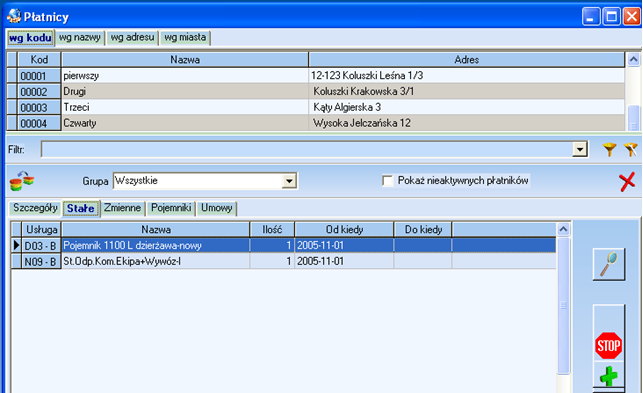Sanitus waste management software
Simple and cyclical invoicing of waste disposal services
SANITUS® waste management software allows to generate invoices for cyclical or one-off services. It has been designed specifically for companies managing waste disposal services.
One of the objectives set during design phase of our software, was to maximally automatize settlement with the contractors. That is why payment slips have barcodes to facilitate the whole settlement process. Those barcodes include following information:
- Client,
- Sales document,
- Payment amount.
Payments settlement is based on the client banking sub-accounts, which allows for precise and fast identification of client transfers (through any file exchange format in the home-banking system). Barcodes can be read in a bank or at the cash desk of the waste disposal company – in case of cash payments, they simplify identification of a client. Our program closely cooperates with the Comarch ERP Optima suite (designed by COMARCH), extracting from it definitions of services and contractors and returning to it completed invoices. Comprehensive payments settlement with clients is performed in the modules called ‘Ksiega Handlowa’ and ‘Kasa/Bank’ that are available in the Comarch ERP Optima suite.
Listing of clients and locating disposal services
SANITUS® allows to input, edit and display all needed pieces of data to manage records of clients and location of the properties, from where waste bins are collected. Databases and windows to input information include, among others:
1. Pricing of services.
List of services and their prices (with historical evolution). Fields: service code (as first letter there is code of group of services), name of service, unit of measure, price, month, moment from which price is effective, term, PKWiU, VAT rate.
Services and their prices can be added, modified, historical prices can be displayed, catalogue of services with current prices can be also printed.
2. Customers (service payers)
Catalogue of customers includes following customer details: ID, name (surname and name), address – city, street, house number, type of payer, information whether customer is ‘VAT payer’, supporting ID (NIP/REGON/PESEL), number and date signing the contract.
Customer has list of assigned standard and additional services. Service payer has number of bins assigned which he/she uses.
List of standard services, that includes: code of services, its name, quantity, date of signing the contract. Those services are settled each month.
List of additional / extra services, that includes: similar parameters as the standard one, but is settled only in specific month in which it is input in the system.
List of containers / bins, that includes ID number of a container, date of starting the exploitation and number of people using it. Deleting the container results in closing the usage of the container and erasing it from the list.
3. Containers
Catalogue of containers for waste, that are numbered and each of them has assigned location and service type. Containers have also specified type, status and date of starting the exploitation. Each container has its own history of disposals and can be assigned to multiple users. If the container is used by multiple customers, then container becomes settled at the level of single customer as a fraction of the total number of properties using it. In the program containers can be added, edited, installed, list current month disposals, finally customers can be also listed.
4. Waste disposal service contract
Standard data concerning contract with a client, with possibility to view the contract document.
5. Data dictionaries: cities, streets, groups of services, groups of clients
Waste management system allows for correct settlement of taxes: VAT and income tax in line with due dates.

Records and settlements of transport department
The module supporting operations of transportation department of the company enables to manage databases of employed drivers and operated vehicles, allows to issue and settle the documents of vehicle operations and work of drivers.
1. Database of vehicles
- List of vehicles used by the company including following information:
registration numbers, supporting number, engine numbers, vehicle body number, operation parameters (type of fuel, fuel consumption norms, additional features) and operational parameters. - Additionally, for the purpose of invoicing the costs, following parameters are included:
rates per km, wages per hour, flat rate per day.
2. Database of drivers / other staff
- List of drivers and other vehicle operators
- Data in the database: name, surname, phone details, document details, certificates and additional data
- Calendar stores schedules / shifts of all drivers and operators, as well as records of driven routes by each of them
3. Register of ‘Route cards’ and ‘Work cards of vehicles and drivers’
- Such register includes data concerning documents of operation: millage meters, fuel consumption, hours worked by vehicles and drivers,
- Monthly reports and periodical analysis of materials, calculation of real costs per km and per hour of operation
4. Managing of print outs of the ‘Route cards’
Issuing of the ‘Route cards’ for drivers and operators of equipment, as well as issuing of documents is based on data included in the above mentioned document (daily, weekly and monthly settlements) – in line with millage meter and fuel consumption.


